 W
WThis list of castles in England is not a list of every building and site that has "castle" as part of its name, nor does it list only buildings that conform to a strict definition of a castle as a medieval fortified residence. It is not a list of every castle ever built in England, many of which have vanished without trace, but is primarily a list of buildings and remains that have survived. In almost every case the buildings that survive are either ruined, or have been altered over the centuries. For several reasons, whether a given site is that of a medieval castle has not been taken to be a sufficient criterion for determining whether or not that site should be included in the list.
 W
WAllington Castle is a stone-built moated castle in Allington, Kent, just north of Maidstone, in England. The first castle on the site was an unauthorised fortification, built during "The Anarchy" (1135–53) and torn down later in the century when royal control was reasserted. It was replaced by a manor house, which was fortified with royal permission in the 13th century. Various alterations and expansions were made by successive owners over the following two centuries. The property was developed into a fortified compound with six towers at irregular intervals along the curtain wall and domestic buildings in the interior, including one of the first long galleries built in England. In 1554 it was seized by the Crown in the course of dispossessing its owner, Sir Thomas Wyatt the Younger, after the failure of his rebellion against Queen Mary.
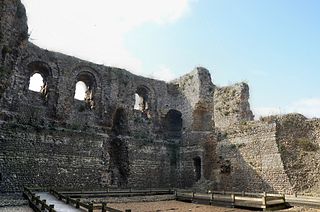 W
WCanterbury Castle is a Norman Castle in Canterbury, Kent, England. It is a five-minute walk from Canterbury East Station and main bus station around City Wall.
 W
WChiddingstone Castle is situated in the village of Chiddingstone, near Edenbridge, Kent, England, 35 miles south-southeast of London and in the upper valley of the River Medway. The castle itself dates from the early 19th century, but incorporates elements of earlier buildings on the same site.
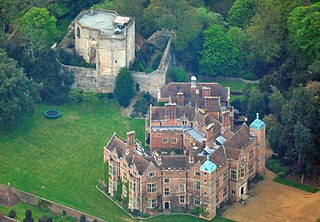 W
WChilham Castle is a manor house and keep in the village of Chilham, between Ashford and Canterbury in the county of Kent, England.
 W
WCooling Castle is a 14th-century quadrangular castle in the village of Cooling, Kent on the Hoo Peninsula about 6 miles (9.7 km) north of Rochester. It was built in the 1380s by the Cobham family, the local lords of the manor, to guard the area against French raids into the Thames Estuary. The castle has an unusual layout, comprising two walled wards of unequal size next to each other, surrounded by moats and ditches. It was the earliest English castle designed for the use of gunpowder weapons by its defenders.
 W
WThe Dane John Mound, also known as the Dane John Gardens, is a former Roman cemetery in the city of Canterbury, Kent. It was converted into a motte-and-bailey castle in the 11th century, and turned into a civic park between 1790 and 1803.
 W
WDeal Castle is an artillery fort constructed by Henry VIII in Deal, Kent, between 1539 and 1540. It formed part of the King's Device programme to protect against invasion from France and the Holy Roman Empire and defended the strategically important Downs anchorage off the English coast. Comprising a keep with six inner and outer bastions, the moated stone castle covered 0.85 acres (0.34 ha) and had sixty-six firing positions for artillery. It cost the Crown a total of £27,092 to build the three castles of Deal, Sandown and Walmer, which lay adjacent to one another along the coast and were connected by earthwork defences. The original invasion threat passed but, during the Second English Civil War of 1648–49, Deal was seized by pro-Royalist insurgents and was only retaken by Parliamentary forces after several months' fighting.
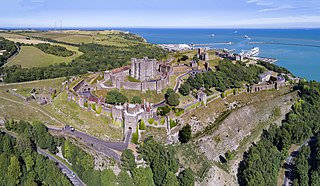 W
WDover Castle is a medieval castle in Dover, Kent, England. It was founded in the 11th century and has been described as the "Key to England" due to its defensive significance throughout history. Some sources say it is the largest castle in England, a title also claimed by Windsor Castle.
 W
WEynsford Castle is a ruined medieval fortification in Eynsford, Kent. Built on the site of an earlier Anglo-Saxon stone burh, the castle was constructed by William de Enysford, probably between 1085 and 1087, to protect the lands of Lanfranc, the Archbishop of Canterbury, from Odo, the Bishop of Bayeux. It comprised an inner and an outer bailey, the former protected by a stone curtain wall. In 1130 the defences were improved, and a large stone hall built in the inner bailey. The de Enysford family held the castle until their male line died out in 1261, when it was divided equally between the Heringaud and de Criol families. A royal judge, William Inge, purchased half of the castle in 1307, and arguments ensued between him and his co-owner, Nicholas de Criol, who ransacked Eynsford in 1312. The castle was never reoccupied and fell into ruins, and in the 18th century it was used to hold hunting kennels and stables. The ruins began to be restored after 1897, work intensifying after 1948 when the Ministry of Works took over the running of the castle. In the 21st century, Eynsford Castle is managed by English Heritage and is open to visitors.
 W
WFolkestone Castle stood on a spur of the North Downs to the north of the town of Folkestone, Kent.
 W
WHever Castle is located in the village of Hever, Kent, near Edenbridge, 30 miles (48 km) south-east of London, England. It began as a country house, built in the 13th century. From 1462 to 1539, it was the seat of the Boleyn family.
 W
WKingsgate Castle on the cliffs above Kingsgate Bay, Broadstairs, Kent, was built for Lord Holland in the 1760s as the stable block of his nearby country residence Holland House. His main residence was Holland House in Kensington, near London. The name Kingsgate is related to an incidental landing of Charles II on 30 June 1683 though other English monarchs have also used this cove, such as George II in 1748. The building was later the residence of John Lubbock, 1st Baron Avebury.
 W
WLeeds Castle is a castle in Kent, England, 5 miles (8 km) southeast of Maidstone. It is built on islands in a lake formed by the River Len to the east of the village of Leeds.
 W
WLeybourne Castle is a 13th-century castle in the parish of Leybourne, Kent. It is situated between West Malling and Larkfield. The two semi circular bastions of the twin towered gatehouse built in 1275 remain and are incorporated into a Tudor farmhouse that was extensively rebuilt around 1930. Some evidence of circular earthworks also remains. The curtain wall was extant until the 18th century but now none of it remains. It has strong links with the similar church very near it.
 W
WLympne Castle is a 18,862 square feet (1,752.3 m2) medieval castle located in the village of Lympne, Kent, above Romney Marsh.
 W
WNewnham Castle was a medieval castle in the village of Newnham, Kent, England.
 W
WQueenborough Castle, also known as Sheppey Castle, is a 14th-century castle, the remnants of which are in the town of Queenborough on the Isle of Sheppey, Kent in England. The castle and the associated planned town were built on the orders of King Edward III from 1361 and named in honour his wife, Queen Philippa. It was the first concentric castle to be built in England, and the only royal castle to be new-built in England during the Late Middle Ages. Overlooking the Swale, then an important waterway approaching the River Medway, Queenborough Castle formed part of the country's coastal defences until 1650 when it was declared to be unfit for use and was almost completely demolished shortly afterwards. The site is now a public park and the only visible remains are some low earthworks.
 W
WRochester Castle stands on the east bank of the River Medway in Rochester, Kent, South East England. The 12th-century keep or stone tower, which is the castle's most prominent feature, is one of the best preserved in England or France.
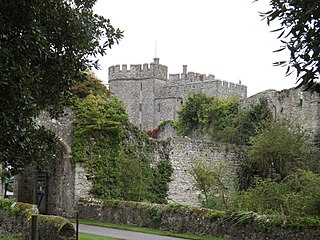 W
WSaltwood Castle is a castle in Saltwood village, one mile (2 km) north of Hythe, Kent, England. Of 11th century origin, the castle was expanded in the 13th and 14th centuries. After the Norman Conquest, the castle was appropriated by the Archbishop of Canterbury Lanfranc and remained the property of the archbishops, with some interruptions, until 1540, when Thomas Cranmer was compelled to cede it to Henry VIII. The castle is reputed to have been the meeting place of the four knights who carried out the assassination of Thomas Becket in 1170. By the 19th century, it was "largely ruinous" and restorations to make portions of the castle habitable were carried out in the 1880s and 1930s. In the late 19th century, the castle was bought by an ancestor of Bill Deedes, the journalist and politician, who grew up there. In the 20th century, it was sold to Sir Martin Conway who commissioned Philip Tilden to undertake a restoration. In 1953, the castle was bought by the art historian Kenneth Clark (1903–1983), and then became the home of his son, the politician and diarist, Alan Clark (1928–1999). It remains the private home of his widow, Jane Clark. The castle is a Grade I listed building.
 W
WSandgate Castle is an artillery fort originally constructed by Henry VIII in Sandgate in Kent, between 1539 and 1540. It formed part of the King's Device programme to protect England against invasion from France and the Holy Roman Empire, and defended vulnerable point along the coast. It comprised a central stone keep, with three towers and a gatehouse. It could hold four tiers of artillery, and was fitted with a total of 142 firing points for cannon and handguns.
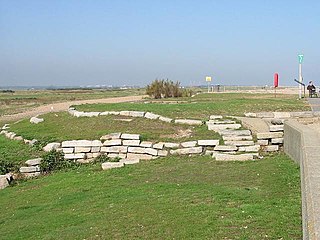 W
WSandown Castle was an artillery fort constructed by Henry VIII in Sandown, Kent, between 1539 and 1540. It formed part of the King's Device programme to protect against invasion from France and the Holy Roman Empire, and defended the strategically important Downs anchorage off the English coast.
 W
WStone Castle is a castle at Stone, near Bluewater in Kent, England. It was built between 1135 and 1140 on the site where William the Conqueror signed a treaty with the men of Kent in 1067.
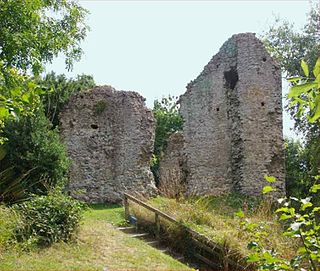 W
WSutton Valence Castle is a ruined medieval fortification in the village of Sutton Valence in Kent, England. Overlooking a strategic route to the coast, the original castle probably comprised an inner and an outer bailey and a protective barbican, with a three-storey high keep on its southern side.
 W
WThurnham Castle or Godard's Castle is situated to the north of the village of Thurnham which is 3 miles north-east of Maidstone, Kent.
 W
WTonbridge Castle is situated in Tonbridge, Kent, England.
 W
WUpnor Castle is an Elizabethan artillery fort located on the west bank of the River Medway in Kent. It is in the village of Upnor, opposite and a short distance downriver from the Chatham Dockyard, at one time a key naval facility. The fort was intended to protect both the dockyard and ships of the Royal Navy anchored in the Medway. It was constructed between 1559–67 on the orders of Elizabeth I, during a period of tension with Spain and other European powers. The castle consists of a two-storeyed main building protected by a curtain wall and towers, with a triangular gun platform projecting into the river. It was garrisoned by about 80 men with a peak armament of around 20 cannon of various calibres.
 W
WWalmer Castle is an artillery fort originally constructed by Henry VIII in Walmer, Kent, between 1539 and 1540. It formed part of the King's Device programme to protect against invasion from France and the Holy Roman Empire, and defended the strategically important Downs anchorage off the English coast. Comprising a keep and four circular bastions, the moated stone castle covered 0.61 acres (0.25 ha) and had 39 firing positions on the upper levels for artillery. It cost the Crown a total of £27,092 to build the three castles of Walmer, Sandown, and Deal, which lay adjacent to one another along the coast and were connected by earthwork defences. The original invasion threat passed, but during the Second English Civil War of 1648–49, Walmer was seized by pro-Royalist insurgents and was only retaken by Parliamentary forces after several months' fighting.
 W
WWestenhanger Castle is a fortified manor house once owned by royalty, located next to Westenhanger railway station and the grandstand of Folkestone Racecourse in Kent. The castle has endured a period of steady decline to near ruination in recent years, but the current owners have engaged a programme of consolidation, conservation and restoration to the castle and adjoining buildings. It is now being used as a conference and wedding venue.